Related Research Articles
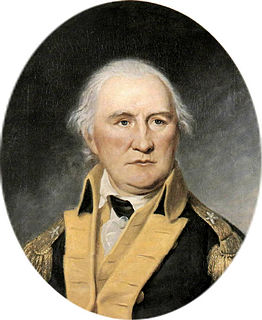
Daniel Morgan was an American pioneer, soldier, and politician from Virginia. One of the most respected battlefield tacticians of the American Revolutionary War of 1775–1783, he later commanded troops during the suppression of the Whiskey Rebellion of 1791–1794.
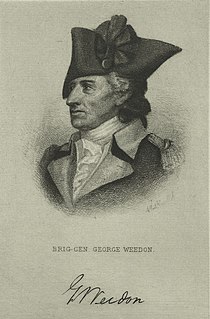
George Weedon (1734–1793) was an American soldier during the Revolutionary War from Fredericksburg, Colony of Virginia. He served as a brigadier general in the Continental Army and later in the Virginia militia. After the Revolutionary War ended he became an original member of the Society of the Cincinnati(Va.).
The 63rd Regiment of Foot was a British Army regiment raised in 1756. Under the Childers Reforms, it amalgamated with the 96th Regiment of Foot to form the Manchester Regiment in 1881.

Sir Banastre Tarleton, 1st Baronet, GCB was a British general and politician. A lieutenant colonel at the end of the American Revolution, Tarleton did not lead troops into battle again.

The British Legion was the name of a British provincial regiment established during the American Revolutionary War, composed of British Loyalist American infantry and dragoons. It was colloquially known as Tarleton's Raiders, the Green Devils, the Green Horse, and the Green Dragoons, after the British officer who led most of its day-to-day activities, Lieutenant Colonel Banastre Tarleton, and the green uniform coats of its officers. "Legion" was an 18th-century term for a military unit the size of a regiment, but consisting of infantry and cavalry, or infantry, cavalry, and artillery, all under one command, to make it more flexible for scouting or irregular operations than a regiment, which consisted of infantry or cavalry alone.

The Royal Fusiliers was a line infantry regiment of the British Army in continuous existence for 283 years. It was known as the 7th Regiment of Foot until the Childers Reforms of 1881.
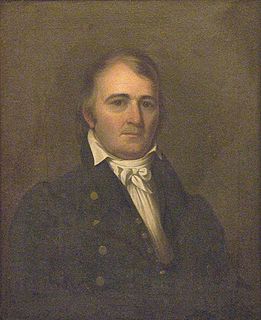
Hardy Murfree was a lieutenant colonel from North Carolina during the American Revolutionary War.
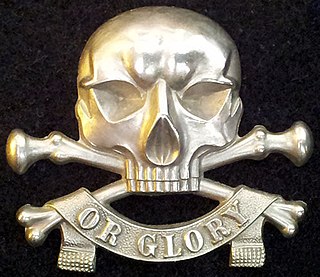
The 17th Lancers was a cavalry regiment of the British Army, raised in 1759 and notable for its participation in the Charge of the Light Brigade during the Crimean War. The regiment was amalgamated with the 21st Lancers to form the 17th/21st Lancers in 1922.

The Battle of Cowpens was an engagement during the American Revolutionary War fought on January 17, 1781 near the town of Cowpens, South Carolina, between U.S. forces under Brigadier General Daniel Morgan and British forces under Lieutenant Colonel Banastre Tarleton, as part of the campaign in the Carolinas. The battle was a turning point in the American reconquest of South Carolina from the British.

The Battle of Waxhaws took place during the American Revolutionary War on May 29, 1780, near Lancaster, South Carolina, between a Continental Army force led by Abraham Buford and a mainly Loyalist force led by British officer Banastre Tarleton. Buford refused an initial demand to surrender, but when his men were attacked by Tarleton's cavalry, many threw down their arms to surrender. Buford apparently attempted to surrender. However, the British commanding officer Tarleton was shot at during the truce, causing his horse to fall and trap him. Loyalists and British troops were outraged at the breaking of the truce in this manner and proceeded to fall on the Americans.
The Battle of Hobkirk's Hill was a battle of the American Revolutionary War fought on April 25, 1781, near Camden, South Carolina. A small American force under Nathanael Greene occupying Hobkirk's Hill, north of Camden, was attacked by British troops led by Francis Rawdon. After a fierce clash, Greene retreated, leaving Rawdon's smaller force in possession of the hill.
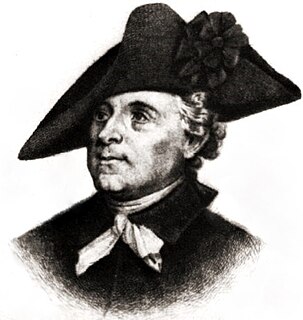
Isaac Huger was a planter and Continental Army general during the American Revolutionary War.
Abraham Buford was a Continental Army officer during the American Revolutionary War, best known as the commanding officer of the American forces at the Battle of Waxhaws. After the war Buford became a member of the Society of the Cincinnati of the State of Virginia.

The 40th Regiment of Foot was an infantry regiment of the British Army, raised in 1717 in Annapolis Royal, Nova Scotia. Under the Childers Reforms it amalgamated with the 82nd Regiment of Foot to form the Prince of Wales's Volunteers in 1881.
The Battle of Monck's Corner was fought on April 14, 1780, outside the city of Charleston, South Carolina, which was under siege by British forces under the command of General Sir Henry Clinton in the American Revolutionary War. The Loyalist British Legion, under the command of Lieutenant Colonel Banastre Tarleton, surprised an American force stationed at Monck's Corner, and drove them away. The action cut off an avenue of escape for Benjamin Lincoln's besieged army. Aside from the British Legion, and the 33rd Foot and 64th Foot led by Lt. Col. James Webster, the force included Loyalists, the American Volunteers, led by Maj. Patrick Ferguson.
The Battle of Wetzell's Mill was an American Revolutionary War battle fought on March 6, 1781, between detachments of Nathanael Greene's Continental Army and militia and Banastre Tarleton's Loyalist provincial troops in Guilford County, North Carolina.

The Honourable Major General Alexander Leslie was a major general in the British Army during the American Revolutionary War. He was the commander of the British troops at the Battle of Harlem Heights. He replaced Cornwallis as commander in the South in 1782.

The 5th Hussar Regiment was a French Hussar regiment.

Colonists who supported the British cause in the American Revolution were Loyalists, often called Tories, or, occasionally, Royalists or King's Men. George Washington's winning side in the war called themselves "Patriots", and in this article Americans on the revolutionary side are called Patriots. For a detailed analysis of the psychology and social origins of the Loyalists, see Loyalist.
References
- ↑ Curtis, Edward Ely (1969), The Organization of the British Army in the American Revolution, p.75
- 1 2 "79th Regiment of Foot (Royal Liverpool Volunteers)". Regiments.org. Archived from the original on 14 August 2004. Retrieved 21 December 2005.
- ↑ Brooke, Richard (1853), Liverpool as it was during the last quarter of the eighteenth century, 1775 to 1800, p.359
- ↑ Katcher, Philip R. N. (1973), Encyclopedia of British, provincial, and German army units, 1775-1783, p.71
- ↑ Marley, David (1998). Wars of the Americas: a chronology of armed conflict in the New World, 1492 to the present. Santa Barbara, USA: ABC-CLIO. p. 326. ISBN 978-0-87436-837-6.
- ↑ Scotti, Anthony J. (2002) Brutal Virtue: The Myth and Reality of Banastre Tarleton, Heritage Books, ISBN 0-7884-2099-2, p. 14
- ↑ Touzeau, James (1910), The Rise and Progress of Liverpool from 1551-1835, p.582